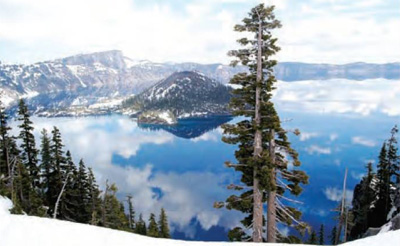Into the Deep: Crater Lake’s ranking as one of the world’s deepest lakes varies by how list is determined
Herald and News
Klamath Falls, Oregon
November 29, 2007
By LEE JUILLERAT
H&N Regional Editor
Is Crater Lake the seventh deepest lake in the world, the eighth or the third?
Depends on how it’s figured.
Owen Hoffman, a director with the Crater Lake Institute and a former park ranger, created a series of scenarios that give argument to any of the three claims.
Typically, Crater Lake is regarded the world’s seventh deepest lake, and the deepest in the U.S., with a maximum depth of 1,949 feet.
Hoffman, whose research at the park from 1966 to 1968 led to a master’s degree in limnology and ecology from Oregon State University, said Crater Lake could be regarded the world’s eighth deepest lake with the recent discovery of sub-glacial Lake Vostok in Antarctica, which is believed to be 2,133 feet deep. The lake surface of Vostok, however, is covered by nearly 13,000 feet of ice that, based on studies, is almost as old as the oldest rocks inside the Crater Lake caldera.
But using other criteria, Hoffman says Crater Lake can be regarded the deepest lake in North America, and third deepest in the world.
Hoffman’s revised ranking is based on determining an average depth.
Great Slave Lake in Canada, with a maximum depth of 2,014 feet, or 614 meters, is the deepest in North America. Great Slave, however, has an average depth of only 73 meters. Crater Lake, created by a series of eruptions that blew off the top of prehistoric Mount Mazama 7,700 years ago leaving the caldera that contains the lake, has an average depth of 1,148 feet, or 349 meters.
Based on Hoffman’s research, the deepest lake in the world, Baikal in Russia, has a maximum depth of 1,637 meters and average depth of 758 meters. The second deepest lake, Tanganyika, has a maximum depth of 1,470 meters and an average depth of 540 meters, which means it retains second place.
“Compared to the average depth of Crater Lake, the other lakes begin to fall behind,” Hoffman said, noting the Caspian Sea, which has a maximum depth of 1,025 meters, has an average depth of 184 meters.
Likewise, Lake Vostok, with its maximum depth of about 1,000 meters, or 2,133 feet, has an average depth of 292 meters, while Lake Issyk-Kul, with a maximum depth of 668 meters, has an average depth of 270 meters. The average depth of Lake Tahoe, which has a maximum depth of 501 meters, is 305 meters.
“Thus,” Hoffman said, “based on its average depth Crater Lake has moved up among the lakes of the world from eighth place — seventh if one excludes the subglacial Lake Vostok — to win the bronze medal.”
***previous*** — ***next***


